NOTICE: Information in this document is preliminary, subject to change without notice, and intended for media use—not for consumers.
The 2017 Civic Type R is features the most powerful engine ever offered in a Honda production vehicle in America. The Type R's 2.0-liter 16-valve i-VTEC® DOHC direct-injected, turbocharged powerplant advances performance on multiple fronts with a peak output of 306 horsepower at 6500 rpm and 295 lb.-ft. of torque between 2,500 and 4,500 rpm. The Civic Type R is the absolute pinnacle of Civic performance, and ranks as the fastest Honda production automobile ever offered in America, with a track top speed of approximately 170 mph.
The 2.0-liter turbocharged engine is made by Honda of America Mfg. at its Anna, Ohio engine plant using domestic and globally sourced parts. Completed engines are shipped to Honda of the U.K. Manufacturing in Swindon, England, where the Type R is manufactured. Specifically engineered for direct injection and turbocharging, with an ultra-lightweight forged steel crankshaft and forged steel connecting rods, the Type R powerplant is designed to offer maximum torque output in the mid-rpm range to provide instantly accessible power.
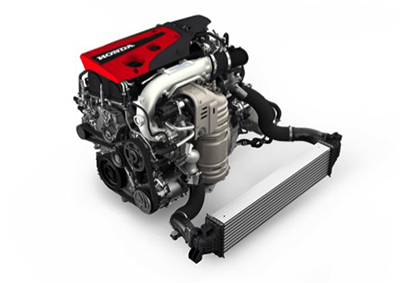 |
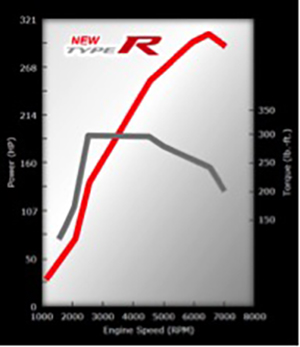 |
Offered exclusively with a 6-speed manual transmission, the high-strength gearbox offers a short-throw shift action and closely spaced ratios tailored to suit the 2.0-liter turbo's power delivery. A driver-selectable rev-matching feature smooths high performance upshifts and downshifts, and to help put the power to the ground, a helical limited-slip front differential is standard.
The Civic Type R engine is Tier3 Bin125 / LEV3-ULEV125 emissions compliant. Though the Civic Type R offers impressive performance, the efficient engine and transmission, along with excellent aerodynamics and low running resistance, result in EPA fuel economy ratings1 of 22/28/25 city/highway/combined mpg.
Key Powertrain Specifications & Features
Turbocharged i-VTEC 2.0-liter, DOHC direct-injected inline-4 engine
- 306 horsepower at 6,500 rpm (SAE net)
- 295 lb.-ft. torque at 2,500-4500 rpm (SAE net)
- Engine redline – 7,000 rpm,
- i-VTEC® with VTC, and VTEC for exhaust cam
- Low inertia mono scroll turbo with electronic waste gate
- Computer-controlled Direct Injection (DI) with multi-hole fuel injectors
- 9.8:1 compression ratio
- Super lightweight, high rigidity steel crankshaft
- Forged steel connecting rods
- Drive-by-Wire throttle system
- Maintenance Minder™ system optimizes service intervals
- 100,000 +/- miles tune-up interval
- Premium Unleaded recommended
Emissions/Fuel Economy Ratings
- Tier3 Bin125 / LEV3-ULEV125 emissions compliant
- U.S. EPA fuel-economy ratings (city/highway/combined) (anticipated)
- 22/28/25 mpg1
Transmission/Drivetrain
- 6-speed Manual
- Selectable Automatic Rev Matching
- Helical Limited-Slip Differential
- Launch Control
Engine Architecture and Features
Turbocharged i-VTEC 2.0-Liter In-Line 4 Cylinder
Assembled in Honda's Anna, Ohio engine plant, the Civic Type R's DOHC 2.0-liter engine is the most powerful engine ever offered in a production Honda in America. With 33-percent greater displacement than the other turbocharged engines offered in the Civic family, the Type R powerplant is engineered to deliver an increase of 101 horsepower and 103 lb.-ft. of torque when compared to the next most powerful Civic, the Civic Si Coupe and Civic Si Sedan. With direct injection, low-inertia high-flow mono scroll turbo system with electrical waste-gate and a maximum of 23.2 psi of turbocharger boost, the Type R powerplant develops the horsepower and torque of a far larger, normally aspirated engine.
The turbocharged Type R 2.0-liter engine is designed to operate on premium unleaded fuel and is rated at 306 horsepower at 6,500 rpm and 295 lb.-ft. of torque between 2,500 and 4,500 rpm. The Civic Type R is rated by the EPA at 22/28/25 mpg1 city/highway/combined.
Cylinder Block and Crankshaft
The Civic Type R’s 2.0-liter inline 4-cylinder engine has a lightweight die-cast aluminum block with reinforced main bearing caps to minimize weight. Centrifugally cast iron cylinder sleeves provide long-lasting durability. In the interest of engine responsiveness, a specially developed, super lightweight forged-steel crankshaft is used exclusively in the Civic Type R. Each journal on the crankshaft is micropolished to reduce operating friction.
Pistons and Connecting Rods
The 2.0-liter engine’s pistons have “cavity-shaped” crowns that help maintain stable combustion and contribute to improved efficiency. The lightweight pistons have a carefully optimized skirt design to minimize reciprocating weight, which minimizes vibration and increases operating efficiency. The pistons are cooled by oil jets directed at the underside of each piston crown and feature an internal “cooling gallery” like Honda Formula 1 engines that is designed to reduce temperature in the piston ring area. Ion-plated piston rings help reduce friction for greater operating efficiency. Special super lightweight, high-strength steel connecting rods are heat-forged in one piece and then “crack separated” to create a lighter and stronger rod with an optimally fitted bearing cap.
Cylinder Head and i-VTEC® Valvetrain

The direct-injected Civic Type R 4-cylinder turbocharged engine has a lightweight pressure-cast aluminum alloy DOHC cylinder head. With exhaust ports cast directly into the cylinder head, the need for a traditional separate exhaust manifold is eliminated, reducing engine weight and simplifying the assembly. The manifold is liquid cooled to help keep heat in check.
A low-friction, silent chain drives dual overhead cams and four valves per cylinder. The cam drive is maintenance free for the life of the engine. To further reduce weight, thin-wall hollow camshafts are used.
To benefit fuel efficiency, emissions and power, the turbo engine utilizes sodium-filled exhaust valves. A hollow chamber within the valve contains sodium that is cooled by the exhaust port cooling jacket. Since the chamber is close to the valve head, the sodium helps to cool the entire valve; and since the valve is internally cooled, it doesn't need the enriched fuel mixture that is generally used in turbo engines to help cool exhaust valves. The resultant leaner mixture reduces emissions, increases fuel efficiency and increases power.
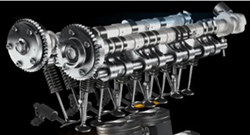
The Civic Type R's 2.0-liter DOHC 16-valve i-VTEC® engine uses an advanced valve control system to combine high power output with high fuel efficiency and low emissions. The system combines intake and exhaust VTC (Variable Valve Timing Control), which continuously adjusts the intake and exhaust camshaft phase, with Variable Valve Timing and Lift Electronic Control (VTEC), which changes valve lift, timing and duration of the exhaust valves.
The "intelligent" portion of the system is its ability to continuously vary the timing of the intake and exhaust camshafts using variable valve timing control (VTC). This helps increase power and also provides a smoother idle (allowing idle speed to be reduced). The cam timing is varied based on input from sensors that monitor rpm, timing, throttle opening, cam position and exhaust air-fuel ratio. The result is increased fuel efficiency and lower emissions.
The cylinder head includes small M12 sparkplugs, down from the more common M14, to save space and weight. The head also includes direct-injection multi-hole fuel injectors with a small-diameter bore. Higher-pressure direct injection optimizes fuel atomization, allowing for more efficient combustion. To provide a high-tumble intake charge that further enhances combustion efficiency, both the intake port and piston crown have special designs.
Direct Injection System
The direct-injection system enables increased torque across the engine's full operating range along with higher fuel efficiency and low emissions. Multi-hole injectors deliver fuel directly into each cylinder (not to the intake port, as in conventional port fuel injection designs), allowing for more efficient combustion. The system features a compact, high-pressure, direct-injection pump that allows both high fuel flow and pulsation suppression, while variable pressure control optimizes injector operation.
High-Flow Exhaust System
The Civic Type R features a specially designed high-flow exhaust system with a unique triple-outlet design centered in the rear of the car. The center outlet is a key factor in the sound of the exhaust note in the Type R interior. The system is engineered to offer a stirring exhaust note under acceleration, coupled with quiet cruising at low power settings.
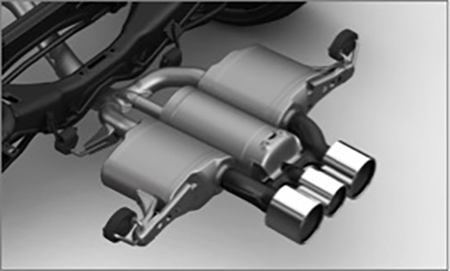
Low Inertia Mono Scroll Turbo System with Electric Wastegate
The turbocharged Civic Type R engine employs a small-diameter, low-mass turbine for maximum responsiveness. The mono scroll housing design helps the turbo build boost even at relatively small throttle openings and low rpm. The electrically actuated wastegate allows boost pressure to be precisely controlled. The Type R's maximum boost pressure, at 22.8 psi, is up from the 16.5 psi found in 1.5-liter Civic turbo models and 20.3 psi in the Civic Si Coupe and Civic Si Sedan.
A large low-restriction intercooler is positioned low in the front of the car where it receives unobstructed airflow when the vehicle is in motion. Intake air travels from the air filter, to the turbo compressor, on to the intercooler, then to the engine's intake ports. The intercooler helps reduce the temperature of air entering the engine, making it denser for greater performance. To reduce weight, the turbo system is plumbed with rigid, lightweight resin composite inlet pipes to carry intake air to and from the intercooler.
Friction Reducing Technology
The Civic Type R engine makes use of a range of friction-reducing technologies designed to improve engine efficiency:
- The outer skirts of the lightweight aluminum pistons feature a low-friction molybdenum coating applied in a dot pattern
- Plateau honing of the cylinder walls removes microscopic high points to further reduce friction while improving the long-term wear characteristics of the engine.
- Low viscosity oil (0W-20)
- Other contributors to overall operating efficiency are a special 2-stage oil pump relief valve, low-friction oil seals, special low-drag piston ring design, low-friction cam chain and a lightweight crankshaft.
Drive-by-Wire Throttle System
The Civic Type R's Drive-by-Wire throttle system replaces a conventional throttle cable with smart electronics that “connect” the accelerator pedal to a throttle valve inside the throttle body. The result is less under-hood clutter and lower weight, as well as quicker and more accurate throttle actuation. Plus, a specially programmed "gain" rate between the throttle pedal and engine offers improved drivability and optimized engine response to suit specific driving conditions.
100,000+/- Mile Tune-up Intervals
The Civic Type R's powerplant requires no scheduled maintenance for 100,000+/- miles or more, other than periodic inspections and normal fluid and filter replacements. The first tune-up includes water pump inspection, valve adjustment, and the installation of new spark plugs.
Maintenance Minder™ System
To eliminate unnecessary service stops while ensuring that the vehicle is properly maintained, the Civic Type R has a Maintenance Minder™ system that continually monitors the vehicle's operating condition. When maintenance is required, the driver is alerted via a message on the Multi-Information Display (MID) on the Driver Information Interface (DII). (See the Interior section for more information.)
The Maintenance Minder™ system monitors operating conditions such as oil and coolant temperature along with engine speed to determine the proper service intervals. Depending on operating conditions, oil change intervals can be extended to a maximum of 10,000 miles, potentially sparing the owner considerable expense and inconvenience over the life of the vehicle. The owner-resettable system monitors all normal service parts and systems, including oil and filter, tire rotation, air-cleaner, spark plugs, coolant, brake pads and more. To reduce the potential for driver distraction, maintenance alerts are presented only when the ignition is first turned on, not while driving.
6-Speed Manual Transmission
For Honda's ultimate performance car, just one transmission is available, an ultra-quick-shifting 6-speed manual transmission (6MT). Topped with a solid aluminum shift knob, the unit offers smooth and precise shift feel with crisply defined shift gates. An updated version of the transmission used in the previous-generation Civic Type R (not available in America), the 2017 Civic Type R transmission has a range of refinements and improvements. To keep temperature in check, the transmission incorporates a cooling fin case design, along with a new liquid-cooled oil cooler.
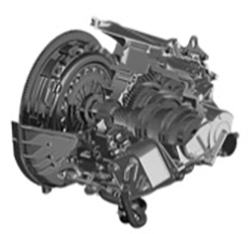
The 6-speed transmission has been engineered to deliver state-of-the-art performance and shift action, with very low internal friction, tight internal tolerances and smooth synchronizers. A lightweight single-mass flywheel is used to sharpen engine response by minimizing clutch inertia. Compared to other Civic 6-speeds, the transmission has a more rigid exterior case, high-strength bearing system, high-strength gears, and greater torque capacity. A constant-mesh helical reverse gear mechanism reduces noise when reverse is selected. A reverse lockout feature prevents the transmission from accidentally being shifted into reverse while the car is moving forward.
Automatic Rev Matching
For optimally matched engine rpm during upshifts and downshifts, the Civic Type R features standard automatic rev matching. When this selectable feature is enabled, the Drive-by-Wire throttle system automatically adjusts the engine rpm during gear changes to match the next gear the driver selects. Automatic rev matching makes the Type R easier to drive by minimizing driveline shock during upshifts and downshifts.
The Civic Type R's automatic rev matching has two operational profiles: in COMFORT or SPORT modes, the rev match system uses a seamless profile, designed to give the Type R a smooth, comfortable shift feel; in +R mode, the system switches to a more aggressive, quick-revving profile designed to complement the faster paced shifting of performance driving. The rev match system can be disabled using the Type R's customizable settings menu.
Helical Limited-Slip Differential
Powerful performance cars with conventional "open" differentials can suffer from excessive wheel spin, particularly from the inner drive wheel when cornering. The Civic Type R's helical-type limited-slip differential (LSD) helps insure that excessive wheel spin doesn't happen, by putting more of the engine's power effectively to the pavement. Under power, the limited-slip differential works to equalize the speed of the two drive wheels. The system never locks the speed of the two drive wheels together as would a locking differential, but instead allows different wheel speeds to accommodate the longer distance the outer wheel must travel when cornering. The LSD allows the Type R to accelerate harder on surfaces with uneven traction, to generate reduced wheel spin when exiting corners, and to enhance the vehicle's responsiveness to throttle inputs in corners. The term "helical" describes the way the differential's gear teeth are cut – which is at an angle to the gear's shaft. Helical gears are quieter in operation and can transmit greater torque than straight-cut (or spur) gears.
Transmission Gear Ratio Comparison
Gear Ratio (X:1) |
2017 Civic EX-T 1.5L Turbo |
2017 Civic Si |
2017 Civic Type R 2.0L Turbo |
|
1st |
3.643 |
3.643 |
3.625 |
|
2nd |
2.080 |
2.080 |
2.115 |
|
3rd |
1.361 |
1.361 |
1.529 |
|
4th |
1.024 |
1.024 |
1.125 |
|
5th |
0.830 |
0.830 |
0.911 |
|
6th |
0.686 |
0.686 |
0.735 |
|
Reverse |
3.673 |
3.673 |
3.758 |
|
Final Reduction Ratio |
4.105 |
4.105 |
4.111 |
Powertrain Feature Comparison
Feature |
2017 Civic EX-T 1.5L Turbo |
2017 Civic Si 1.5L Turbo |
2017 Civic Type R 2.0L Turbo |
|
Engine Type |
L-4 Turbocharged |
L-4 Turbocharged |
L-4 Turbocharged |
|
Displacement (cc) |
1498cc |
1498cc |
1996cc |
|
Horsepower @ rpm |
174 @ 5500 (6MT) |
205 @ 5700 |
306 @ 6500 |
|
Torque |
167 @ 1800-5500 (6MT) |
192 @ 2100-5000 |
295 @ 2500-4500 |
|
Bore and Stroke (mm) |
73 x 89.4 |
73 x 89.4 |
86 x 85.9 |
|
Compression Ratio |
10.6:1 |
10.3:1 |
9.8:1 |
|
Maximum Boost (psi) |
16.5 |
20.3 |
22.8 |
|
Fuel Injection |
Direct |
Direct |
Direct |
|
Programmed Fuel Injection (PGM-FI) |
|
|
|
|
Valvetrain |
16-Valve DOHC w/dual VTC |
16-Valve DOHC w/dual VTC |
16-Valve DOHC VTEC w/intake VTC |
|
Drive-by-Wire Throttle System |
• |
• |
• |
|
Low-Inertia MONO Turbocharger |
• |
• |
• |
|
Variable Ex. Valve Lift |
|
|
• |
|
Variable Cam Timing |
Dual |
Dual |
Dual |
|
Transmission |
CVT/6MT |
6MT |
6MT |
|
Launch Control |
|
|
• |
|
Automatic Rev Matching |
|
|
• |
|
Helical Limited-Slip Differential |
|
• |
• |
|
Front Wheel Drive |
• |
• |
• |
|
100K +/- Miles No Scheduled Tune-Ups |
• |
• |
• |
Fuel Economy and Emissions Ratings Comparison
Ratings |
2017 Civic EX-T |
2017 Civic Si |
2017 Civic Type R |
|
EPA Fuel Economy Ratings1 (city / highway/ combined) (anticipated) |
31/42/35 (6MT) |
28/38/32 (6MT) |
22/28/25 (6MT) |
|
Recommended fuel |
Regular Unleaded |
Premium Unleaded |
Premium Unleaded |
|
CARB emissions rating |
LEV3-ULEV125/LEV3-SULEV30 |
LEV3-ULEV125 |
Tier3 Bin125 / LEV3-ULEV125 |
(See the Specifications & Features document for all data.)
1Based on 2017 EPA fuel-economy ratings. Use for comparison purposes only. Your mileage will vary depending on how you drive and maintain your vehicle, driving conditions and other factors.